Grasslands National Park – 10 Reasons To Visit
Grasslands National Park is one of the great modern achievements of Parks Canada. One usually thinks of a national park as a pristine environment that has been preserved for all time from the forces of exploitation and development and in most cases that is a correct assumption. Grasslands National Park is quite different. It is an ecosystem that was once natural mixed grass prairie, hosting a great variety of flora and fauna, much of which is unique to the prairie environment. Home to aboriginal hunters since just past the last Ice Age, the prairies were transformed by the introduction of the horse by the Spanish in the 16th century. For a fleetingly short historical period the Cree, Sioux, Blackfeet and Assiniboine tribes were able to easily sustain themselves from the bounty of the immense bison herds that roamed the area. Then came the buffalo hunters. From a total of what was estimated to be over 50 million animals, less than 2,000 were left by 1890. Aside from possibly the decimation of the passenger pigeon, this was the greatest animal holocaust in North American history.
With the demise of the bison, the original prairie was broken by the farmer’s plough and transformed into domesticated agricultural crops, notably wheat. These fields of billowing grassland crops are what comes to mind when most people think of ‘the prairies’ today. What escaped the plough was used as fodder for the herds of cattle that replaced the bison. Those lands were fenced in with that most useful and at the same time, terrible invention, barbed wire. Not surprisingly the combination of farming and ranching virtually destroyed the original mixed grass prairie and most of the plants and animals that had evolved with it. I should be clear that the original prairie in Canada was not simply one type of ecosystem. Here is a map, courtesy of Prairie Pollination, that shows that there are in fact five distinct types of prairie in western Canada.
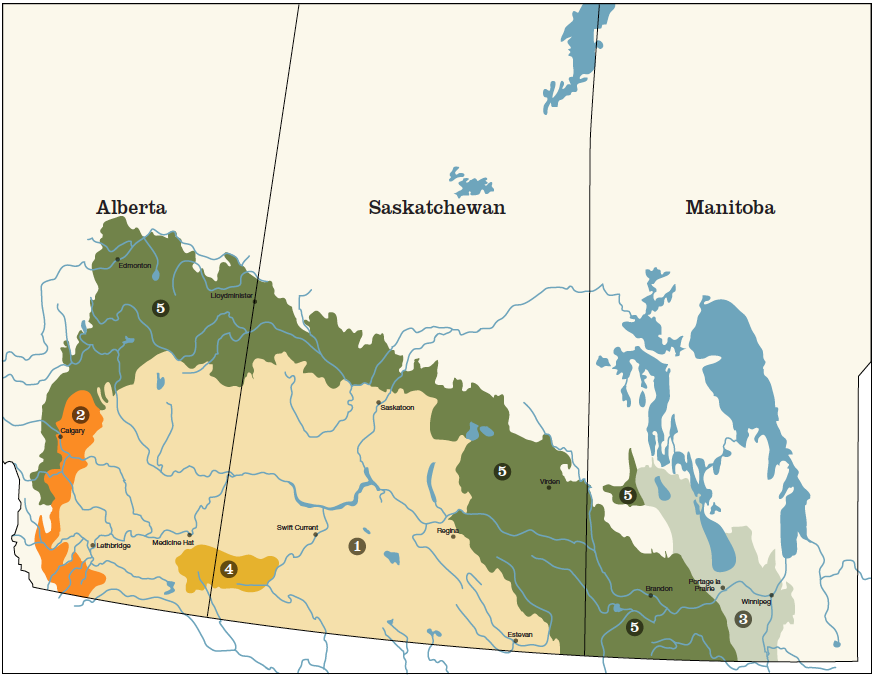
No. 1 is the mixed grass prairie that includes the lands in Grasslands National Park. No. 2 is a band of fescue prairie that stretches along the foothills of the Rockies. No. 3 is tall grass prairie found only in Manitoba. No. 4 is Aspen Parkland Fescue found in the Cypress Hills area of Alberta and Saskatchewan. You can read more about it in my post on the Cypress Hills. Lastly, No. 5 is Fescue and Mixed Grass Prairie found on the on the northern side of the mixed grass prairie. I’ll be seeing some of that on an upcoming visit to Prince Albert National Park.
This map portrays the prairies as they existed when the Europeans arrived. It is estimated that less than 1% of the original mixed grass prairie (No.1) still existed by the mid 20th century.
Establishment of Grasslands National Park
The idea of establishing a national park to preserve what was left of the original mixed grass prairie first began in the 1950’s and 1960’s, but wrangling between the province and the feds over oil and gas rights prevented real progress until 1988. In that year a commitment was made by both governments to establish the park and the rough boundaries were drawn up. Unlike previous heavy handed expropriations in the establishment of national parks that had led to local resentments, the land for Grasslands National Park was purchased through voluntary sales. These included some huge ranches and commitments for future sales once the current owners died or were ready to leave. Thus, the boundaries of the park are continuing to expand and eventually there will be a total of 900 sq. kms (350 sq. miles) in two blocks. Today they are about 60% of the way there. It was not until 2001 that Grasslands National Park formally came into existence, so it’s one of our newer parks.
Getting to Grasslands National Park
As I mentioned the park consists of two blocks. The western block is situate in the Frenchman River Valley and consists of rolling hills with a distinct geomorphology of buttes, coulees and the wide valley. This is the area I will be writing about in this post. The other block consists of ‘badlands’ and the uplands of Wood Mountain. Unfortunately I won’t be getting to that part on this trip.
Grasslands National Park is headquartered in the small town of Val Marie, also the home of NHL Hall of Famer, Bryan Trottier. The Interpretive Centre is extremely modest by national park standards. Outside there is this interpretive panel with a list of a Top 12 Amazing Experiences. As we have only one night and day here we won’t get all twelve in, but let’s get started.
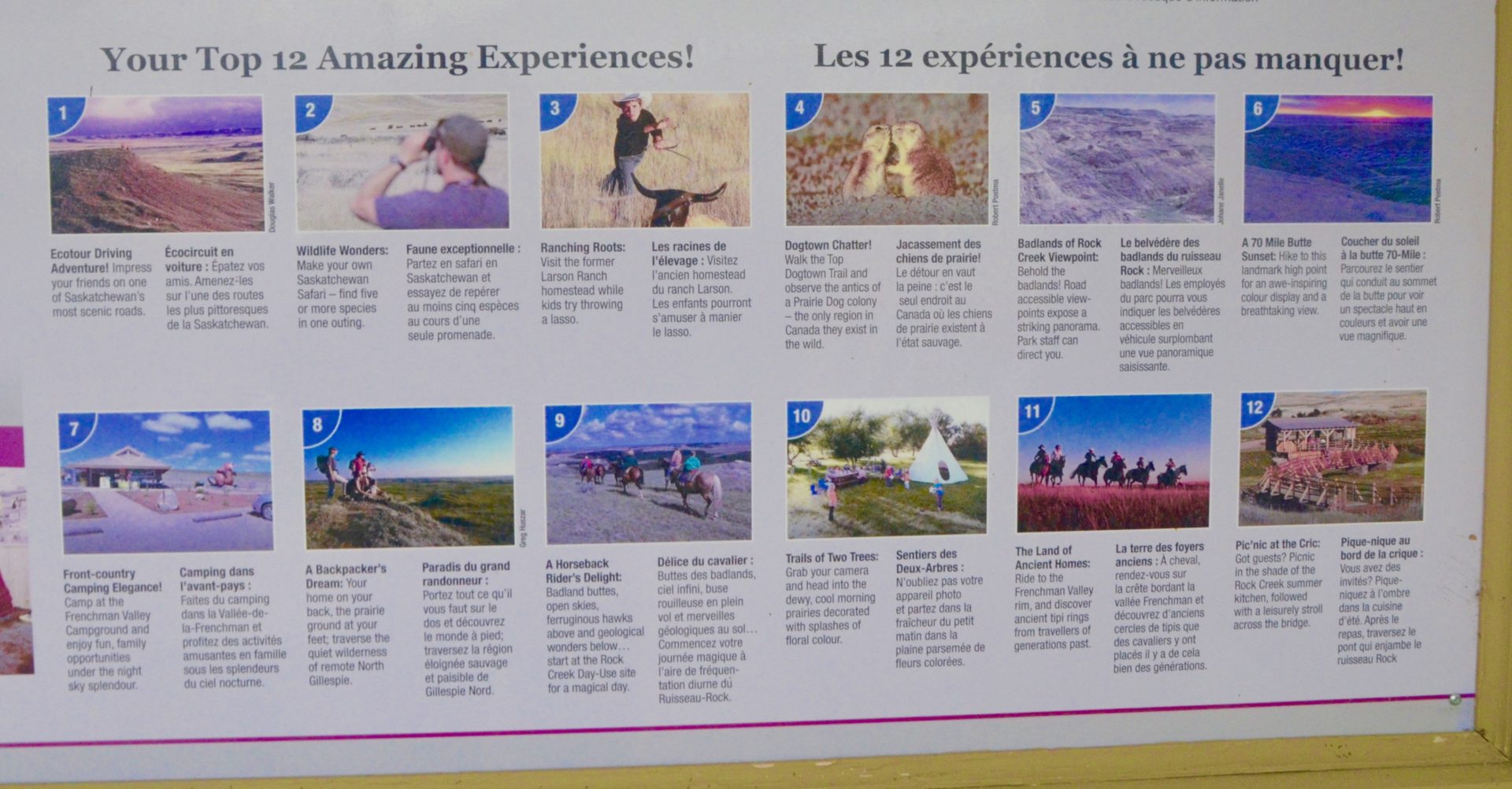
In the Interpretive Centre we pick up a map and the lady on duty points out where we are most likely to see the bison herd as well as the only campground in the western section at Frenchman Valley. There are so few visitors to Grasslands National Park that there is no entry fee. From Val Marie it’s still a fair drive to the park entrance and once you leave the town there are absolutely no services, so you need to have everything required before entering the park. All roads in the park are dirt and quite rough in some places. The drive to the park gate is very scenic with the occasional abandoned farmstead. We passed one vehicle going the other way.
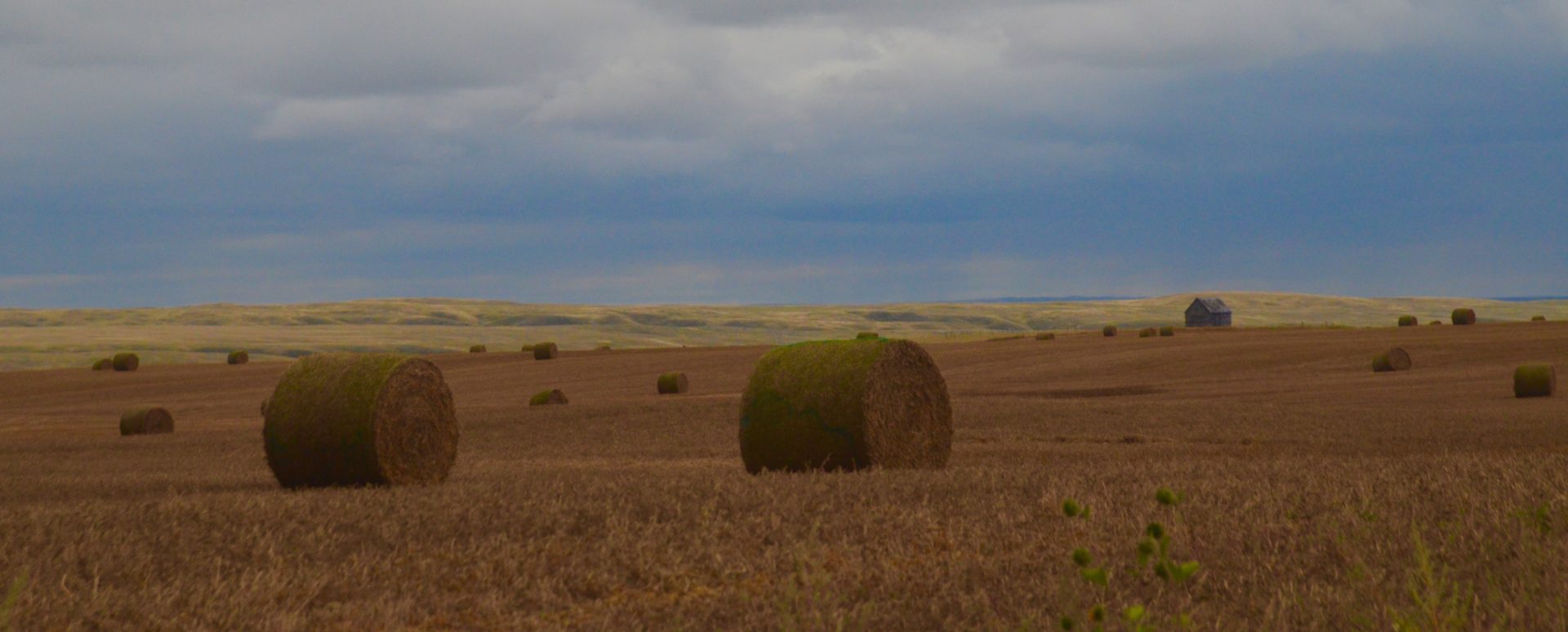
Crossing over a Texas gate we arrive at the entrance and begin our journey into a world that, thanks to our cupidity and selfishness as a species, we almost lost.
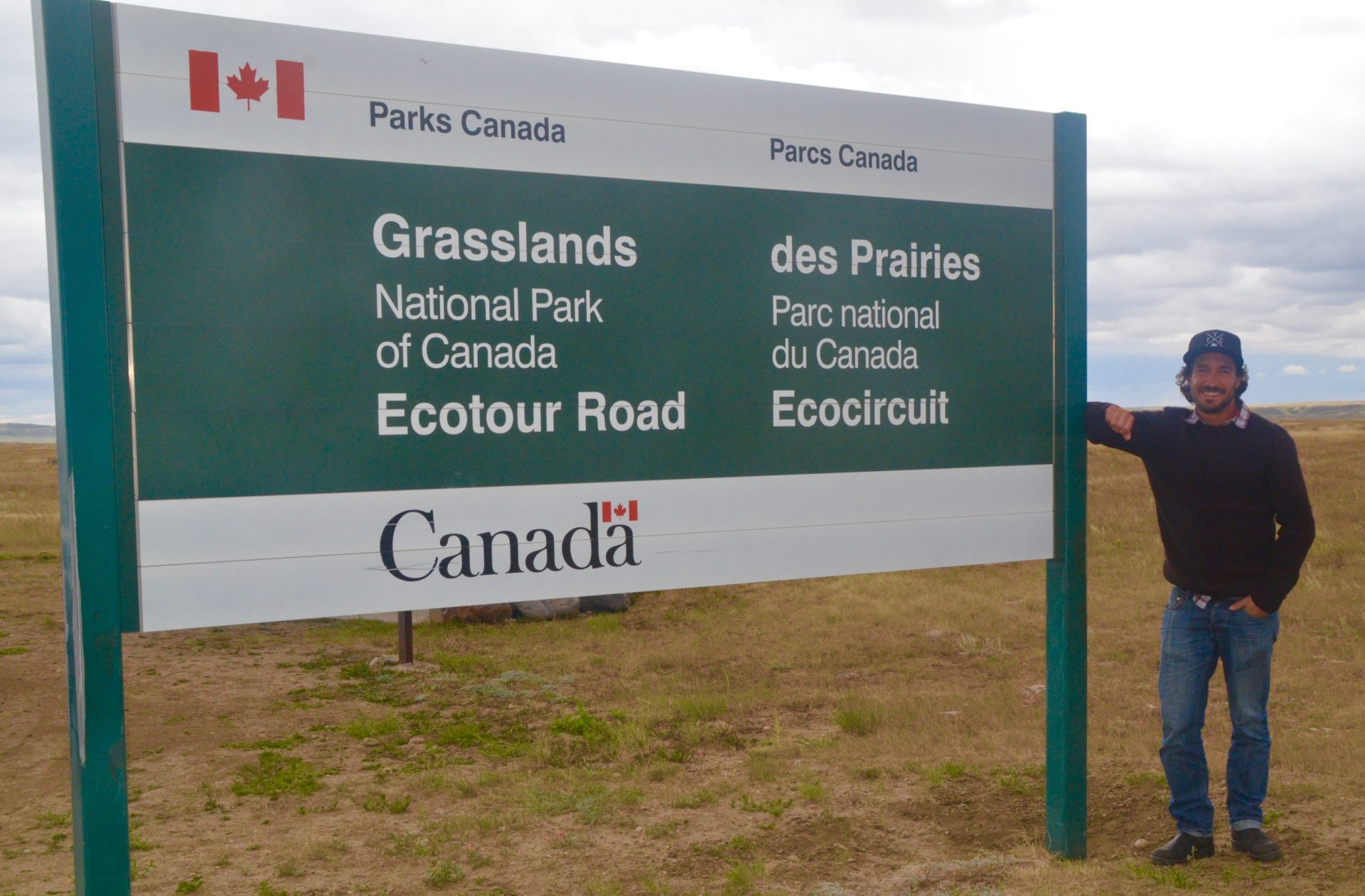
Almost from the moment you pass through the park’s boundaries you start seeing things you won’t see outside the park – massive, solitary bison bulls and prairie dog towns. I’ll come back to these when we drive the Grasslands Ecotour Road in its entirety tomorrow. Which does bring me to the first of the reasons to visit Grasslands National Park.
No. 1 – Frenchman River Valley
The Frenchman River and the valley it has cut is the dominant feature of the western sector of Grasslands National Park. We have crossed it three times already just getting here from Cypress Hills. Each time the valley gets wider and the descent from upland, steeper. This shot gives a rough idea of how far down the valley floor is from the park entrance. It does not convey the actual beauty of the valley which is a green oasis in an otherwise arid land.
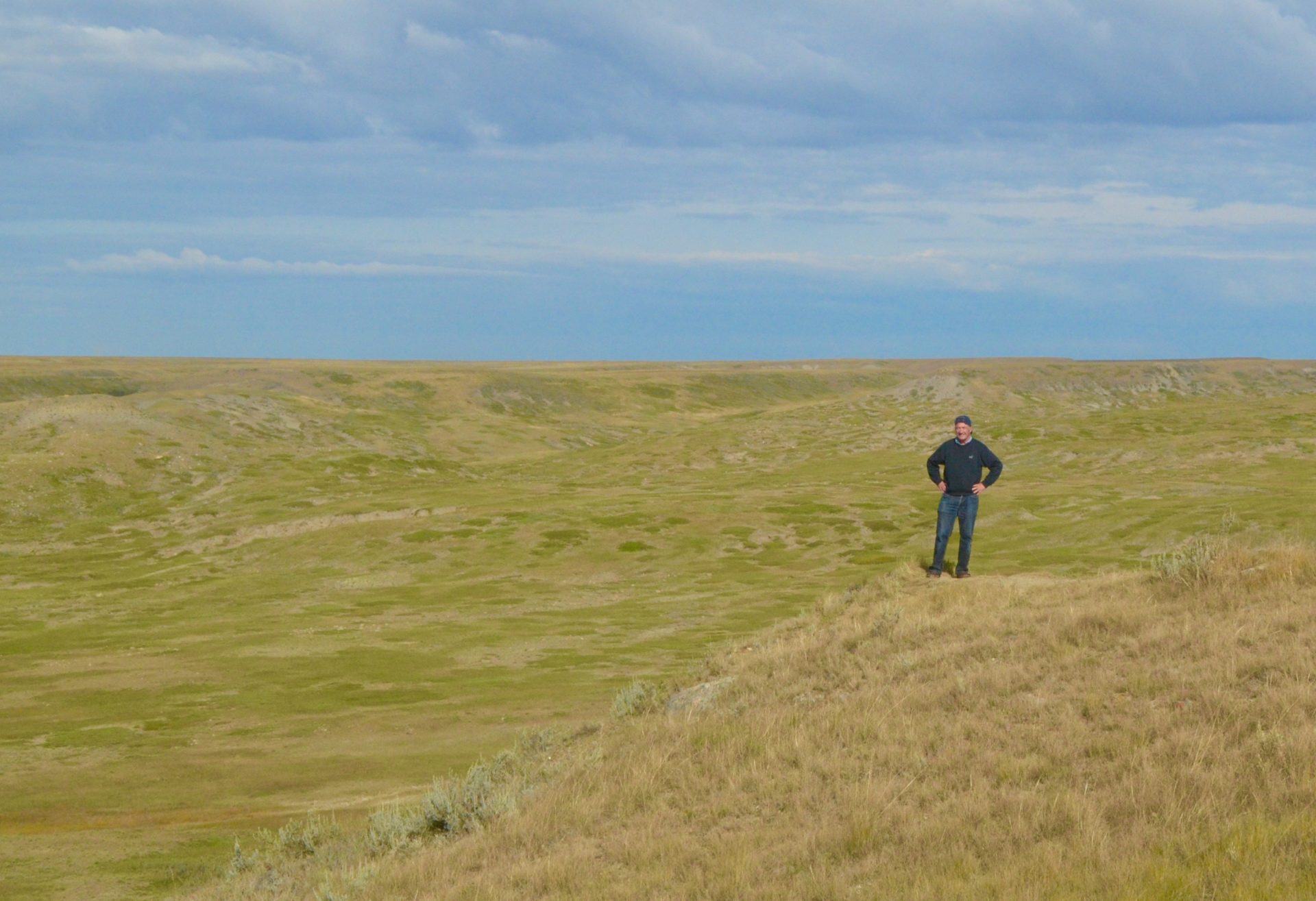
The road down to the valley and the river crossing is so steep that a truck hauling a trailer in front of us decided to turn back. That gives us pause, but at about 15 kms. per hour we do inch the RV down onto the valley floor from where its relatively clear if not smooth sailing all the way to the campground.
No. 2 – Frenchman River Campground
As noted, this is the only campground in the western sector. Approaching it I can’t help but notice that there are only three other groups here, all in RVs. That’s us on the right. Imagine, we have over 100 sq. miles and there’s only us and these few other people.
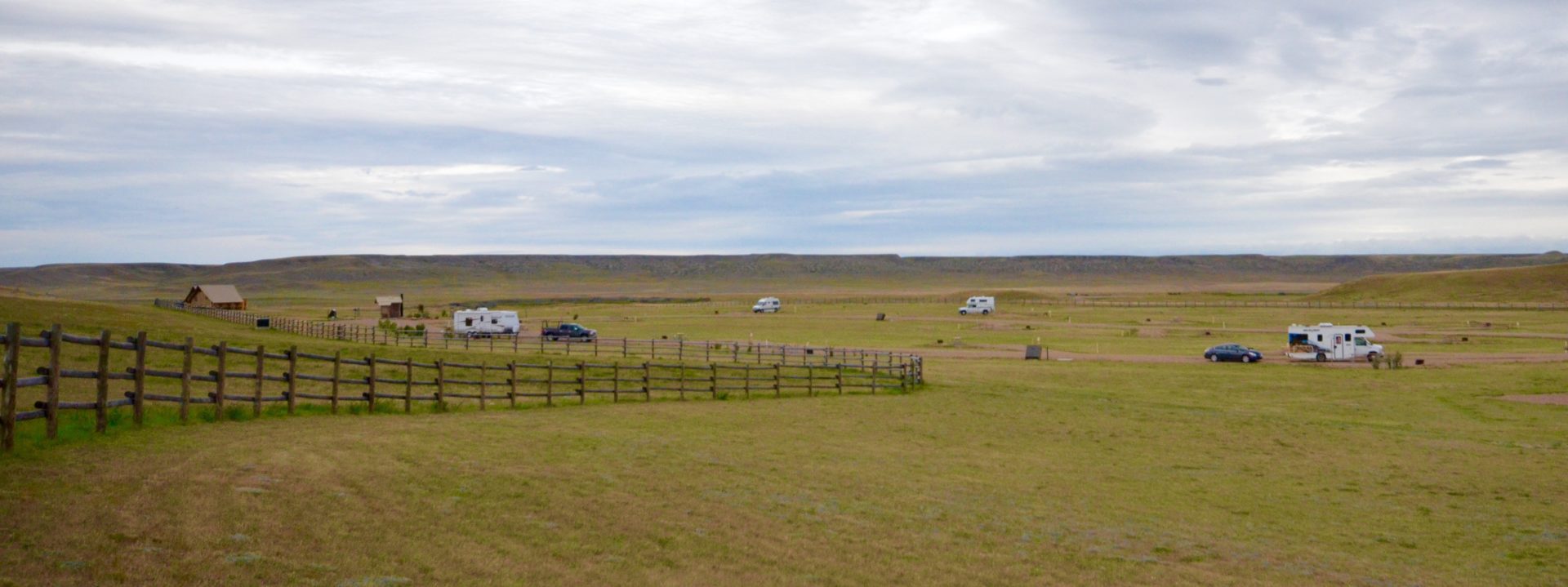
The campsites do have electricity and there are taps for potable water. The toilets are compostable pits. There is one large building in which to take shelter. On the map it is indicated that there is wifi here, but there isn’t and there certainly isn’t cell coverage. So, if you like getting away from it all, Frenchman River Campground is a great place to do it.
On the other hand if you are not up to camping, you can rent one of four Otentniks on site. They each come with their own gas barbecue. Only one was in use the night we stayed.
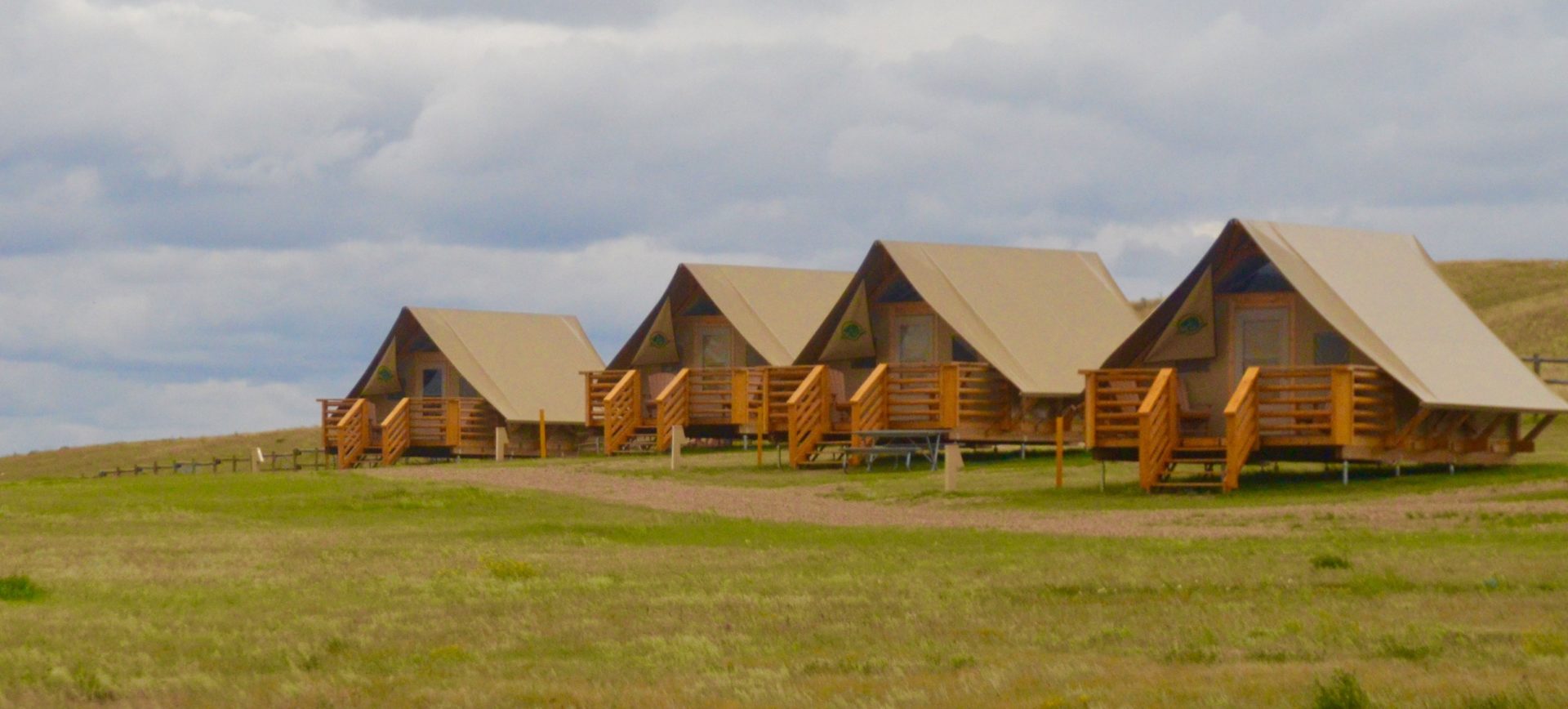
The sky around the campground was alive with dozens of barn swallows and a little investigation revealed that there were nests under the eaves of every man made structure. Most held two chicks, but one mother had managed to raise four.
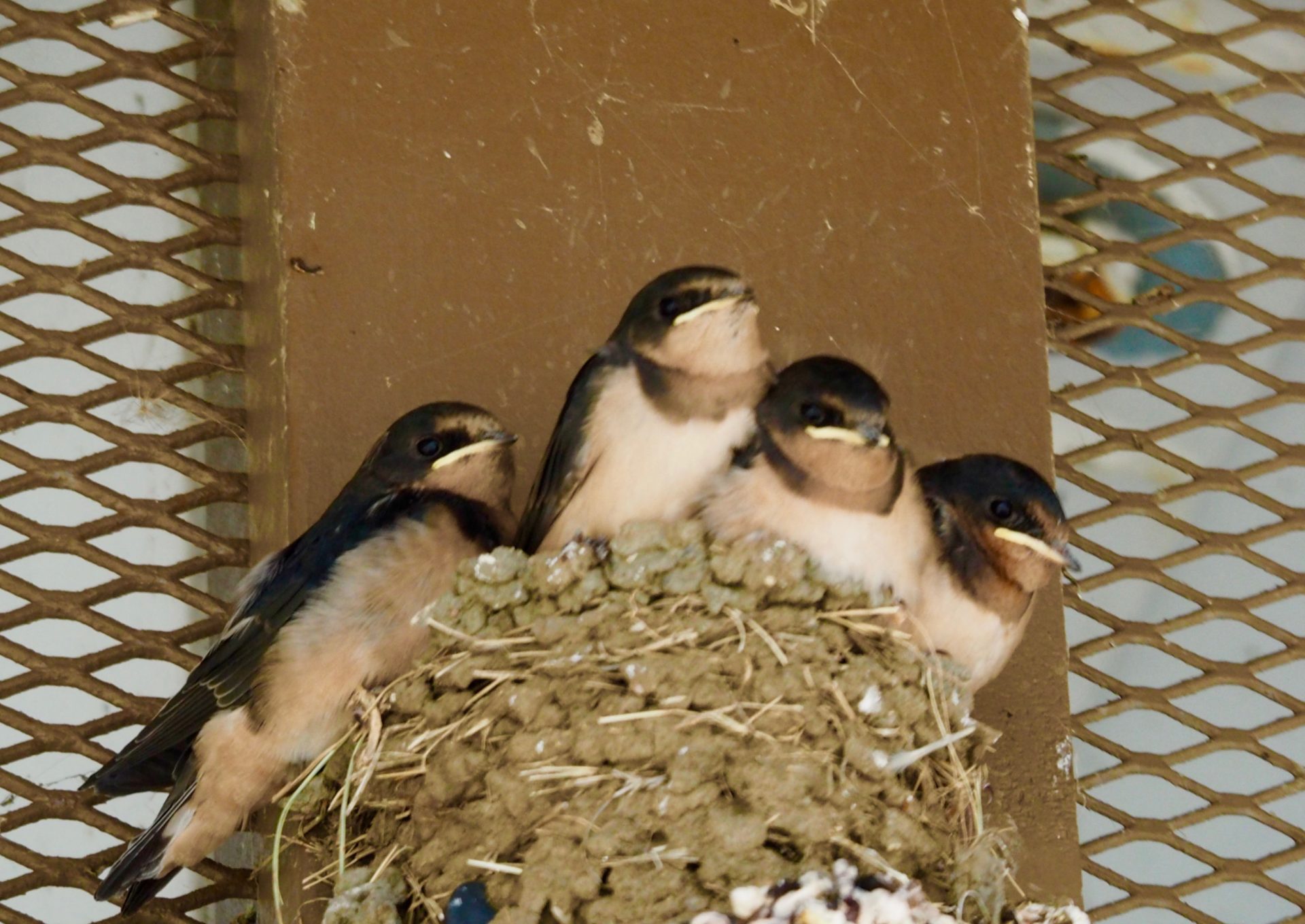
No. 3 – The Sunsets
We arrived quite late in the afternoon and after cooking supper on one of the gas barbecues we set out to watch the sun set over the Frenchman River Valley. There is a path that leads up to an overlook of the valley where Parks Canada has wisely placed two of its rapidly becoming famous, red chairs. From here my son Dale and I watch and sip our wine as the sun becomes a glowing bright ball before it sinks below the horizon.
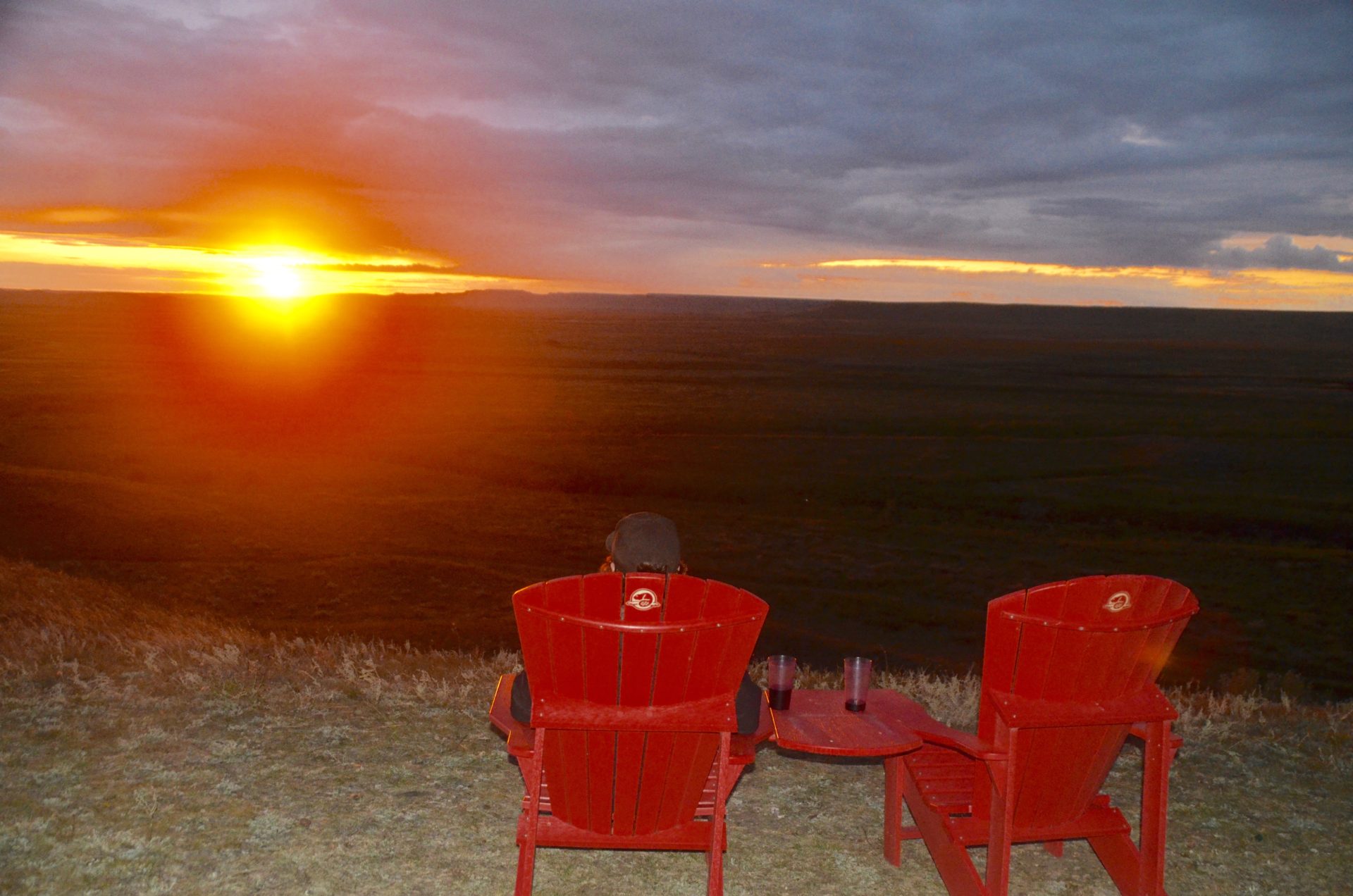
No. 4 – The Night at Grasslands National Park
In the past month I have been to three of the best dark sky areas in Canada – Trout Point Lodge in the SouthWest Nova Biosphere, Cypress Hills and now Grasslands National Park. On each occasion, including tonight I have been cursed by overcast skies. As you can see from the photo above the stars will not be seen tonight, much less the Northern Lights. Here’s what you might see if the sky is clear. This picture is from Parks Canada, but a search of night photos from Grasslands National Park will bring up even more fantastic ones. A Dark Sky Preserve is ironically, anything but dark. If the Northern Lights aren’t displaying, the brightness of the Milky Way will be an equally amazing display.
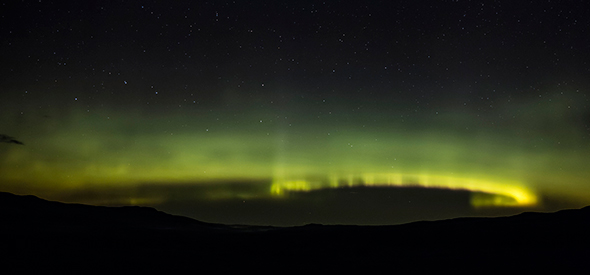
We did get one nighttime experience at Frenchman Valley campground that was worth staying for just to hear. That was the sounds of coyotes in all directions around us. They were yowling and yipping in a way that indicated that they were clearly communicating with each other and occasionally one would let out the baying that is the most iconic sound you can hear in the Canadian west.
No. 5 – The Sunrise
Now the sunrise itself is not that great because the actual rise is obstructed by the hills surrounding the campsite, but what is really neat is the great shadows thrown by the sun as it crests the horizon. It bathes the entire prairie in this beautiful suffused light that makes for great pictures. As you can see the clouds cleared up once they made sure we couldn’t see the stars for the increasing light.
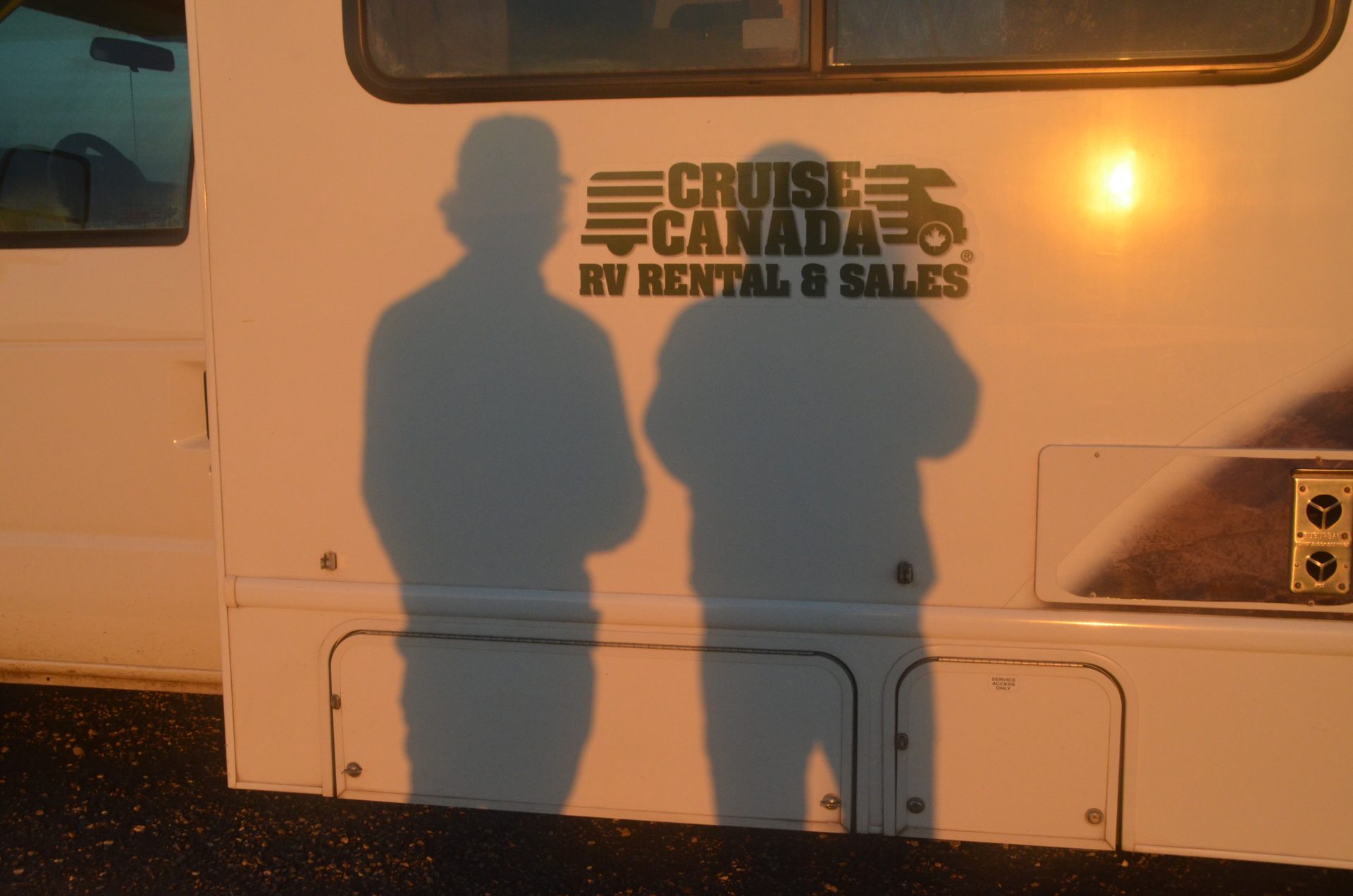
No. 6 – The Grasslands National Park Ecotour Drive
There are many ways to explore the western sector of Grasslands National Park, but by far the most common is to drive the 80 kms. (50 mile) Ecotour Drive. Only about half of it inside the park and we were advised at the Interpretive Centre that this is where we would see the majority of the wildlife that is the feature of this drive. Having completed the entire loop, I can say the advice we were given was dead on as we saw little outside the park boundaries other than lots of deer and one loggerhead shrike. Still the landscape outside the park is beautiful rolling ranchland. The park boundary is also a good place to see the difference between what is true mixed grass prairie and what is land that has been transformed by human activity. The difference is striking. All of the other six highlights of Grasslands National Park can be seen or accessed from the Ecotour Drive.
No. 7 – The Original Mixed Grass Prairie
We got up at first light and headed south on the Ecotour Drive with the understanding that this was the best time to see wildlife. Someone forgot to tell that to the prairie dogs as at the first prairie dog town we came to they weren’t up yet.
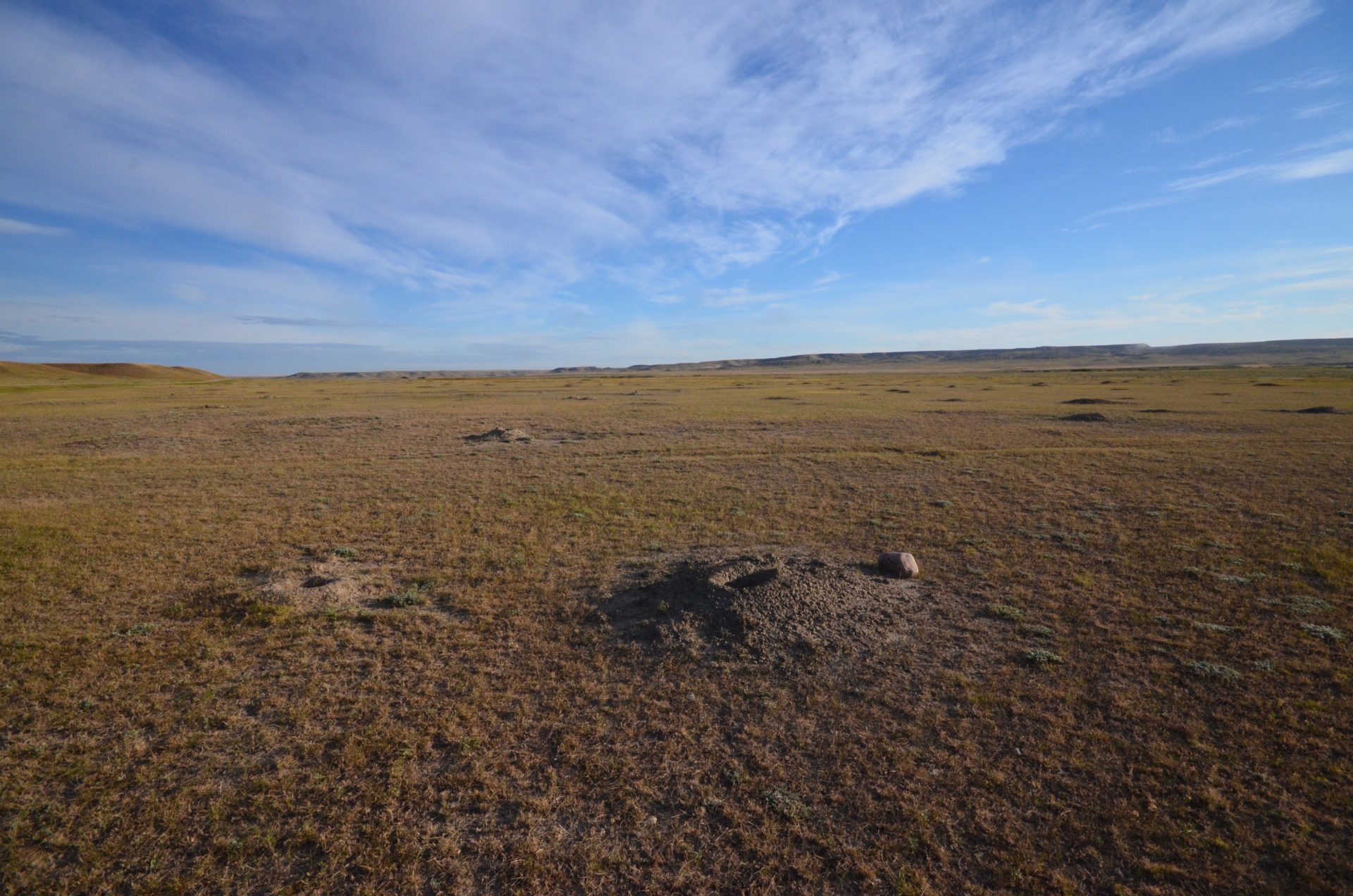
Our first stop was at the head of the Larson Interpretive Trail where this rabbit had apparently spent the night on a picnic table.
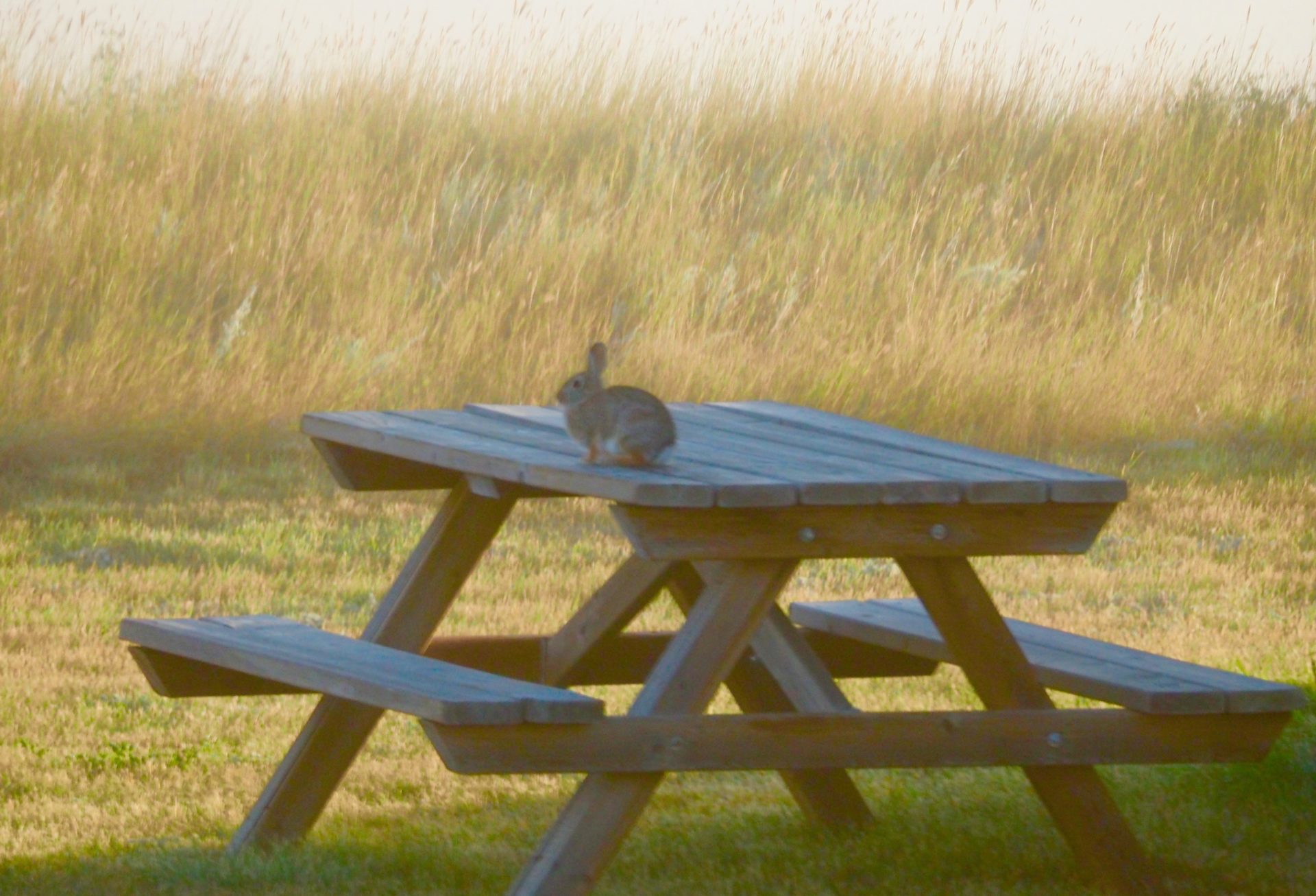
Notice the prairie grass behind the rabbit. This was a great spot to actually walk through a true mixed grass prairie and believe me, it was not like anything I’d seen before. There was a wide variety of grasses with a lot of wildflowers thrown in.
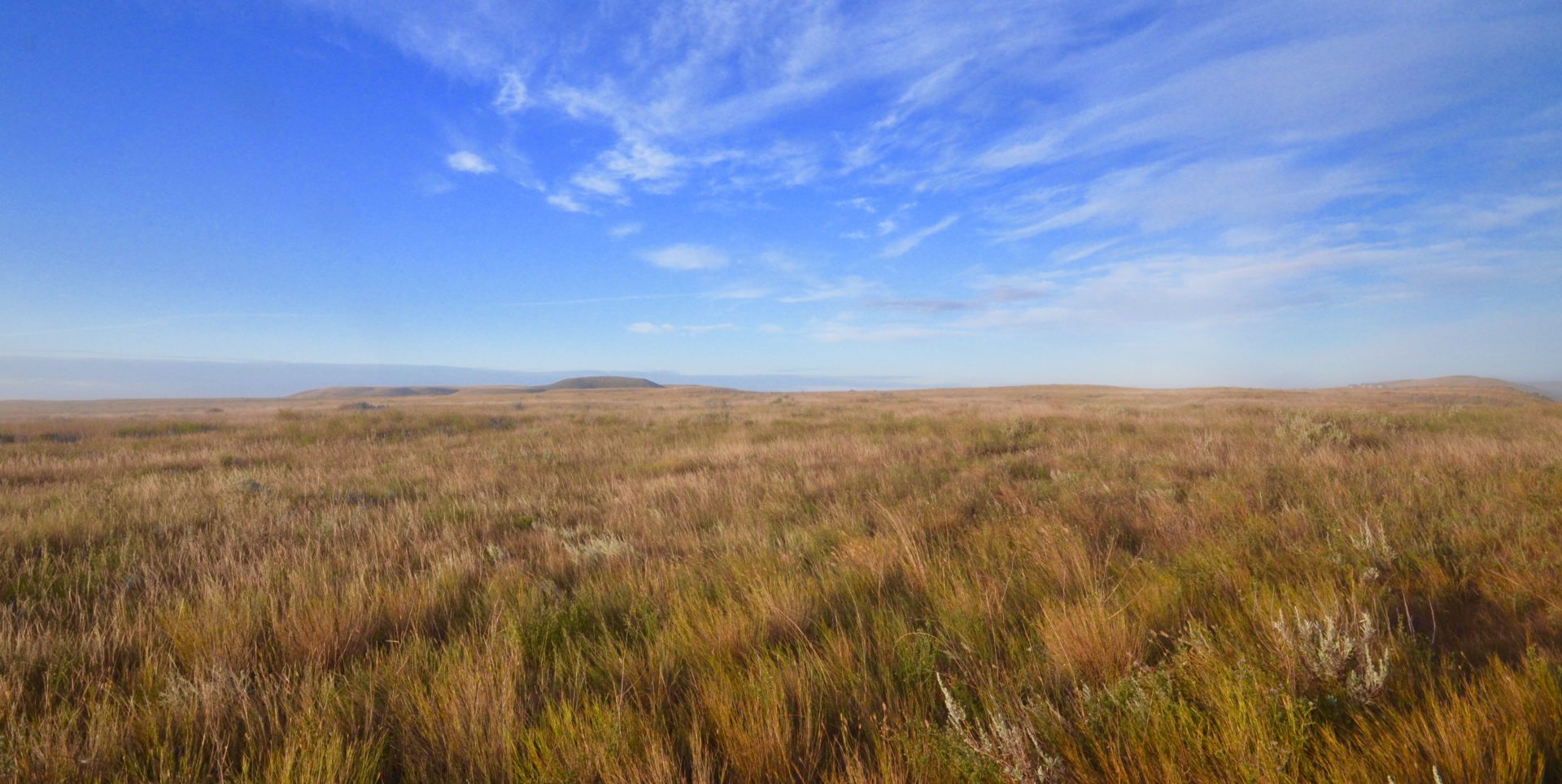
My idea of the prairies being a collection of fields all growing one crop was shattered for good. This is what a true prairie looks like.
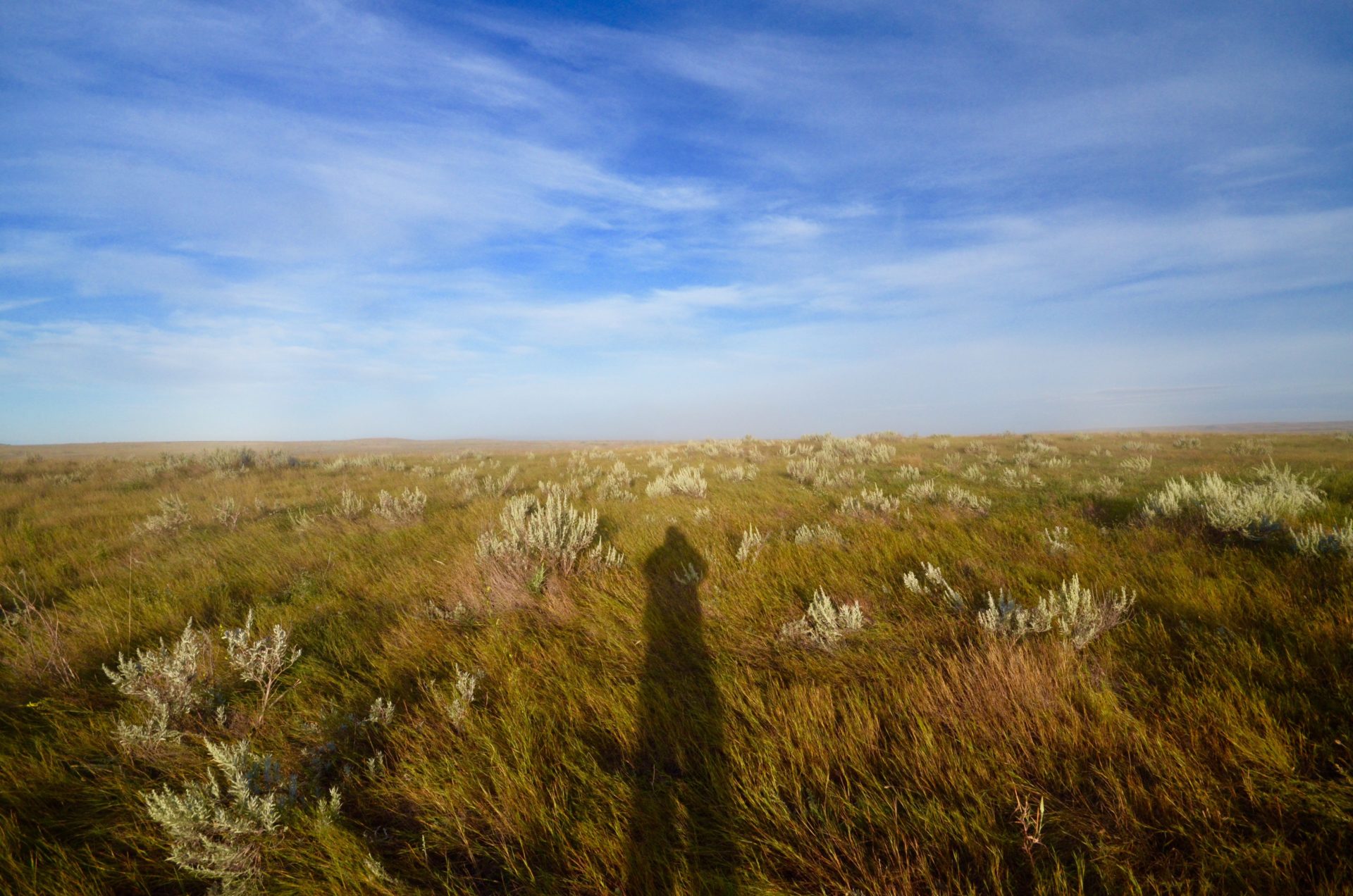
No. 8 – Larson Interpretive Trail
This is a short 1.4 km. (1 mile) walk through the prairie down to the banks of the Frenchman River. It showcases a combination of history and great scenery. This is what’s left of the Larson ranch which was one of the first purchased by Parks Canada. This was once pastureland for cattle and horses.
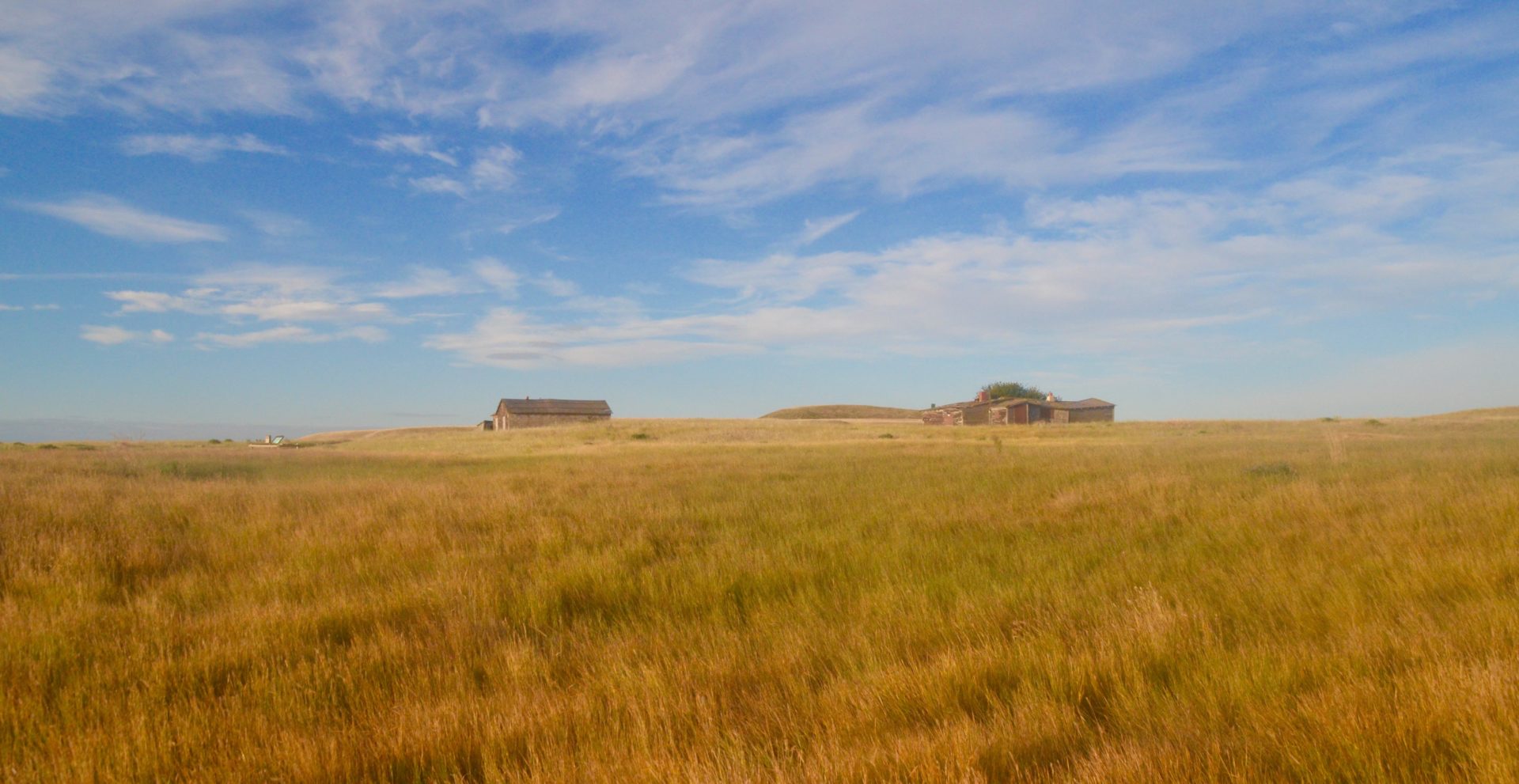
This is Will James’ cabin, nearby Larson ranch. Will James was a character right out of a dime western novel. He came west at age 15 and became a cowhand traveling throughout the west. He was sent to prison for cattle rustling and after his release turned his life around and became a famous artist, novelist, movie actor and all round symbol of a dying way of life. He spent a good part of his career in this cabin. Not bad for a guy whose real name was Joseph Dufault who hailed from St. Nazaire, Quebec.
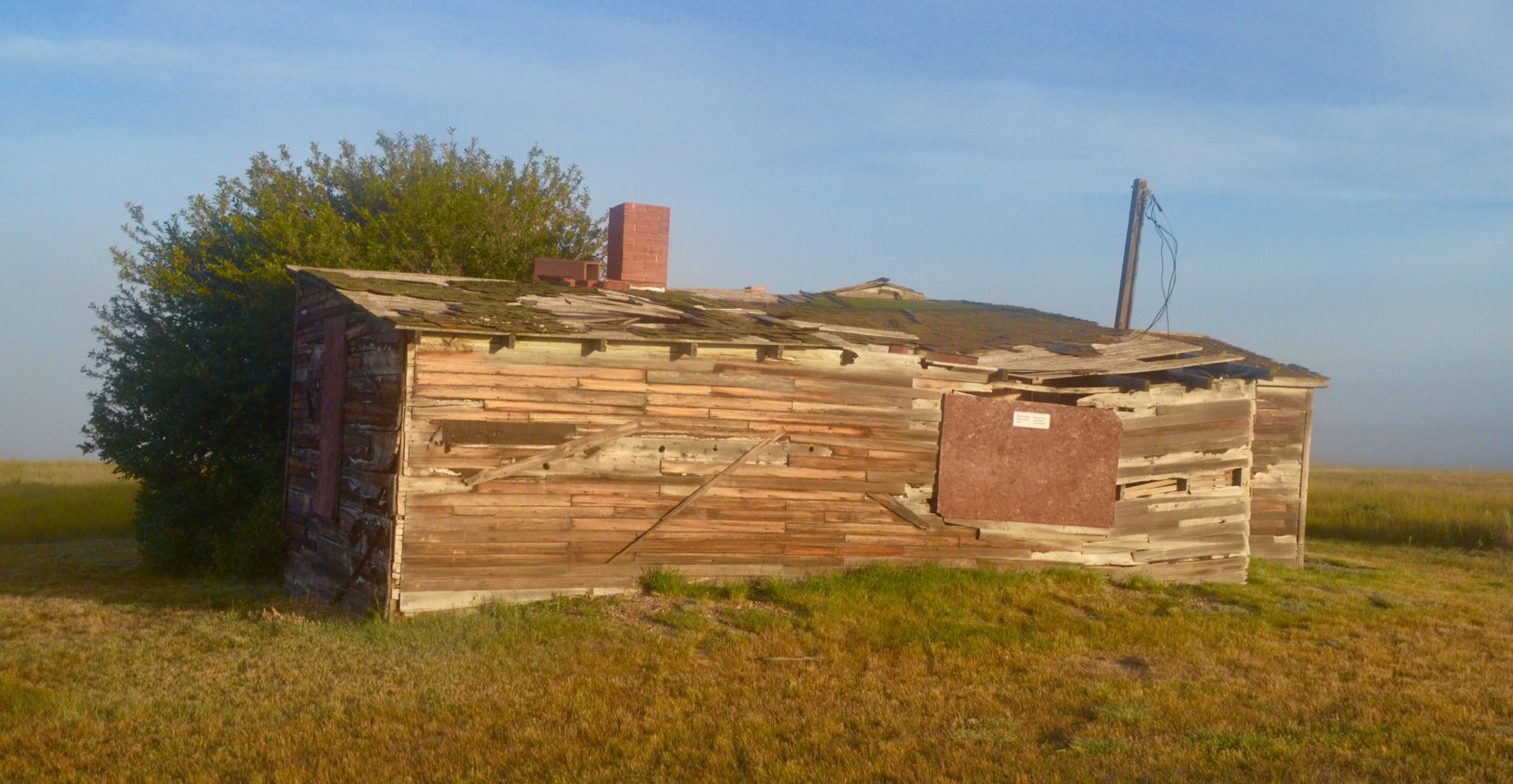
The mist was rising from the Frenchman River as we approached and it seemed the best way to capture the scene was in black and white.
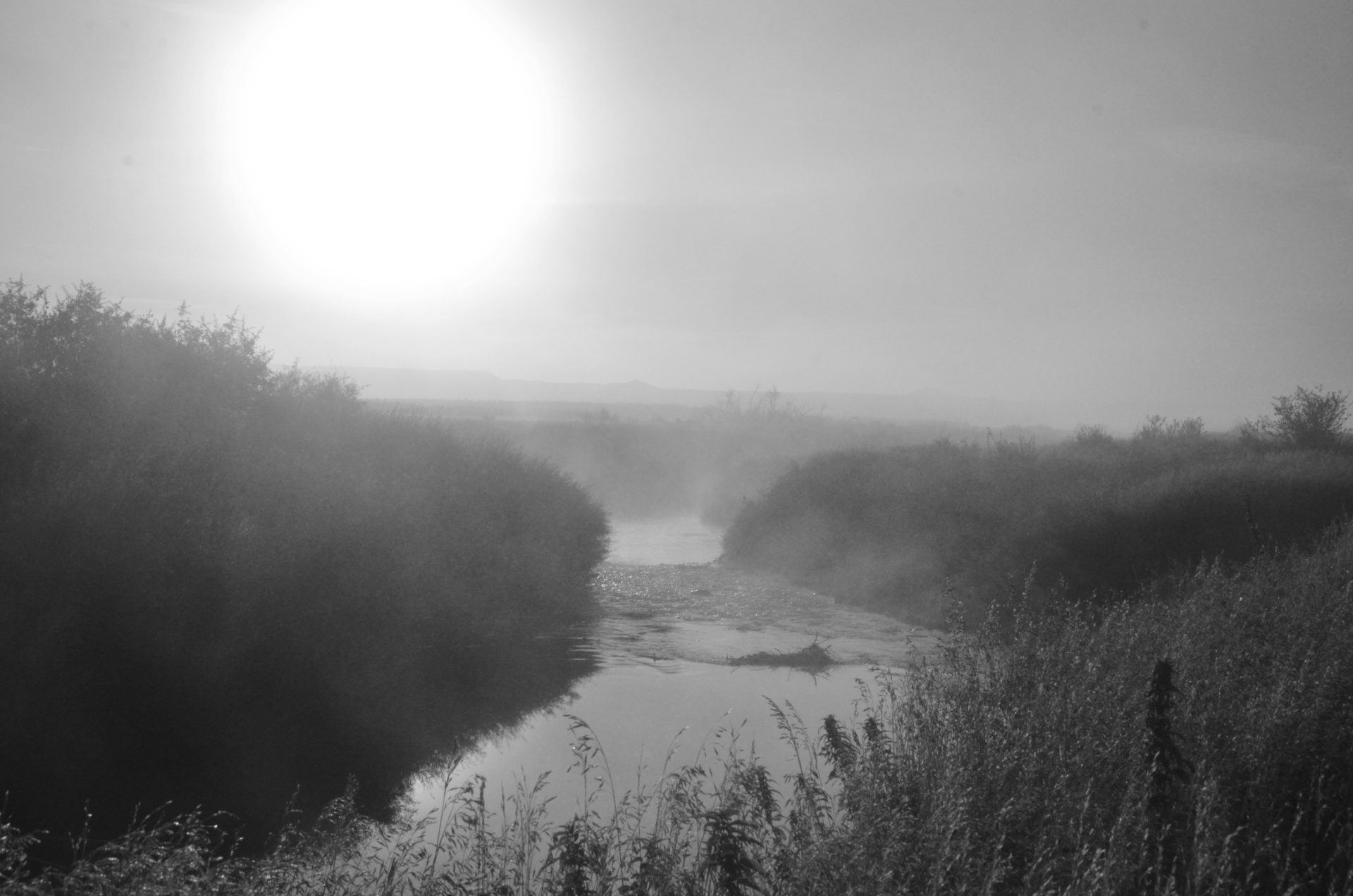
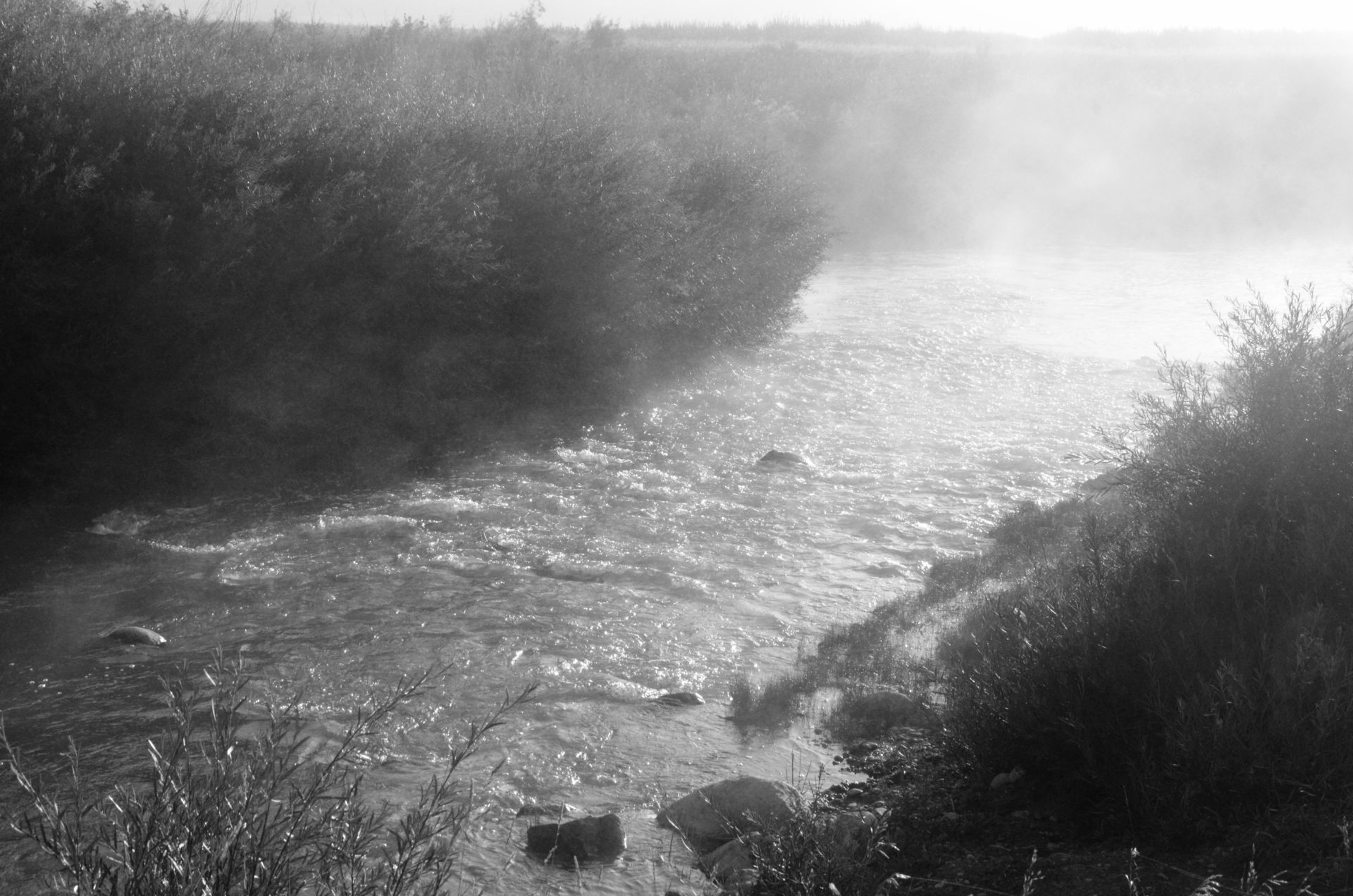
This was once a popular river crossing for cattle herds
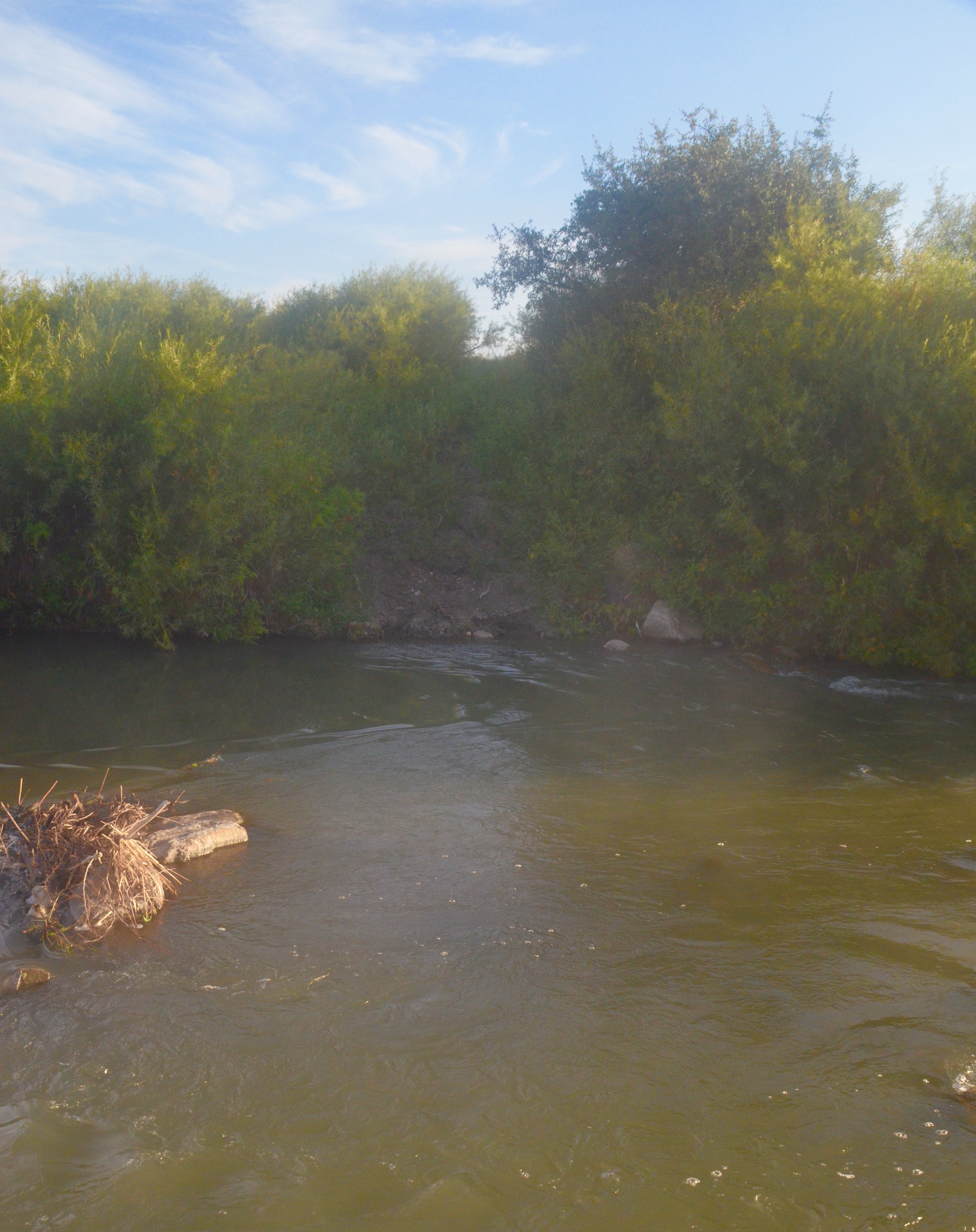
No. 9 – The Wildlife
There were four types of wildlife I definitely wanted to see on this Ecotour Drive – bison, prairie dogs, burrowing owls and prong horned antelope. A real bonus would be a black footed ferret or a rattlesnake. As it turns out we saw the first three, but not the others. The lady at the Interpretive Centre said that the antelope could be seen anywhere along the drive, but I guess they were camera shy today. Still what we did see was more than enough to satisfy our needs.
The bison were found in two different ways. Solitary male bison were actually right beside the road at a number of places, including this guy who looks likes he came right off a buffalo nickel.
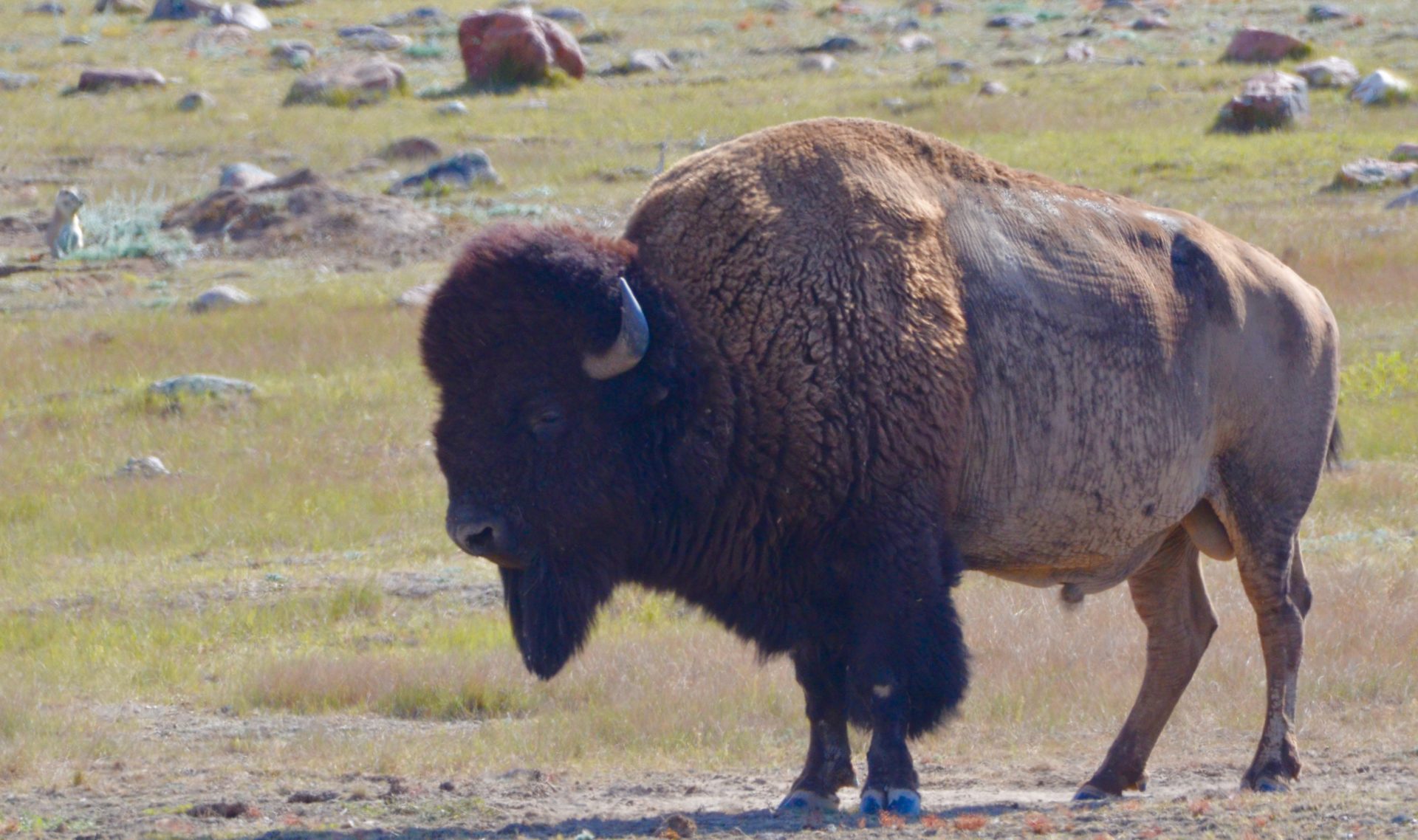
The bulls tended to keep their distance from each other.
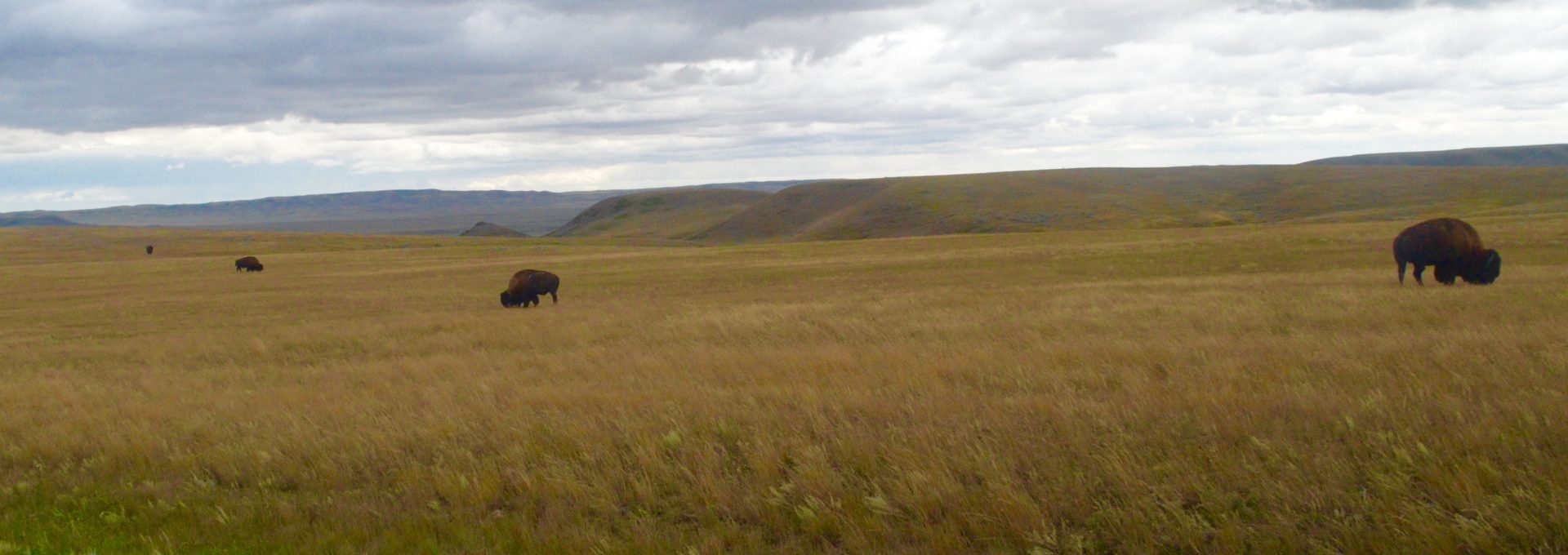
The other way to see bison was to find the main herd where the females and young would be congregated. We found the herd not far past Larson Ranch, some half a mile away. There were enough of them that the size of the herd gave me just an inkling of what these prairies might have looked like before the buffalo hunters came.
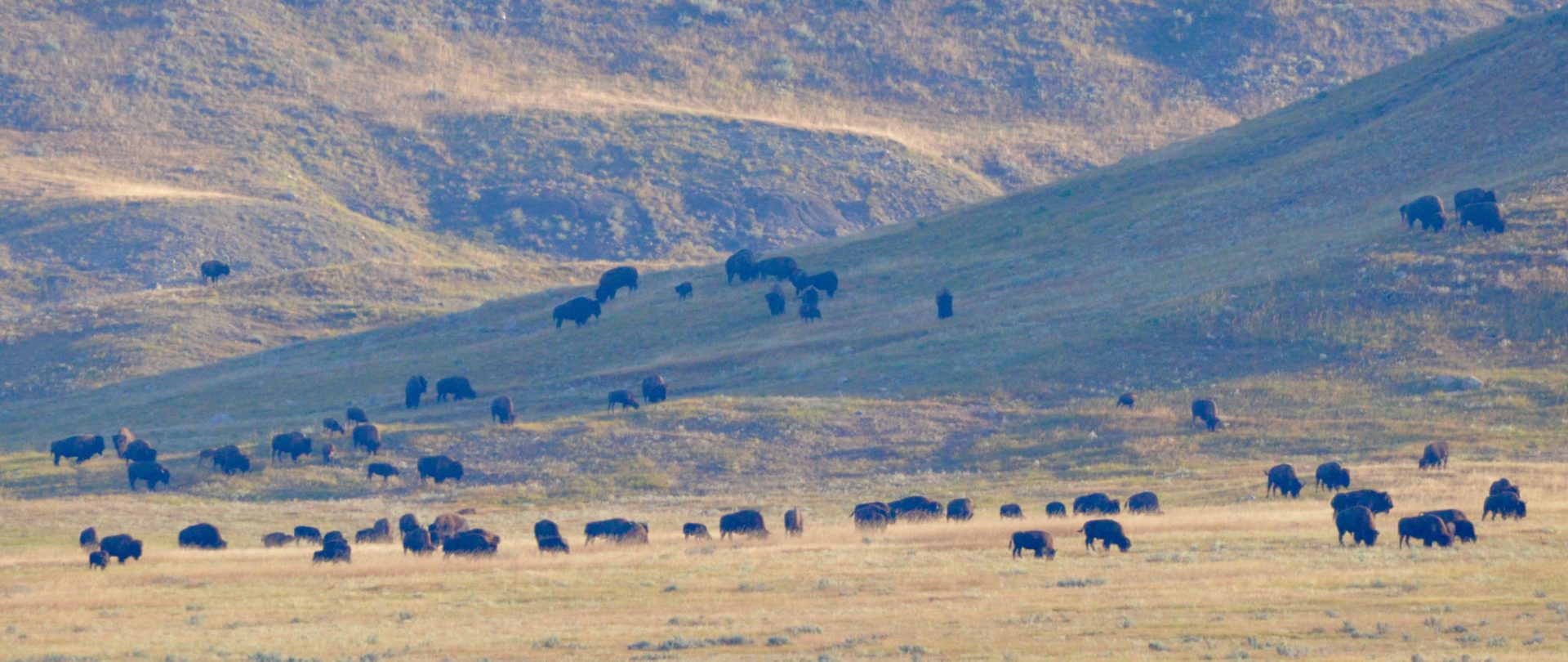
Here’s what they looked like without a telephoto.
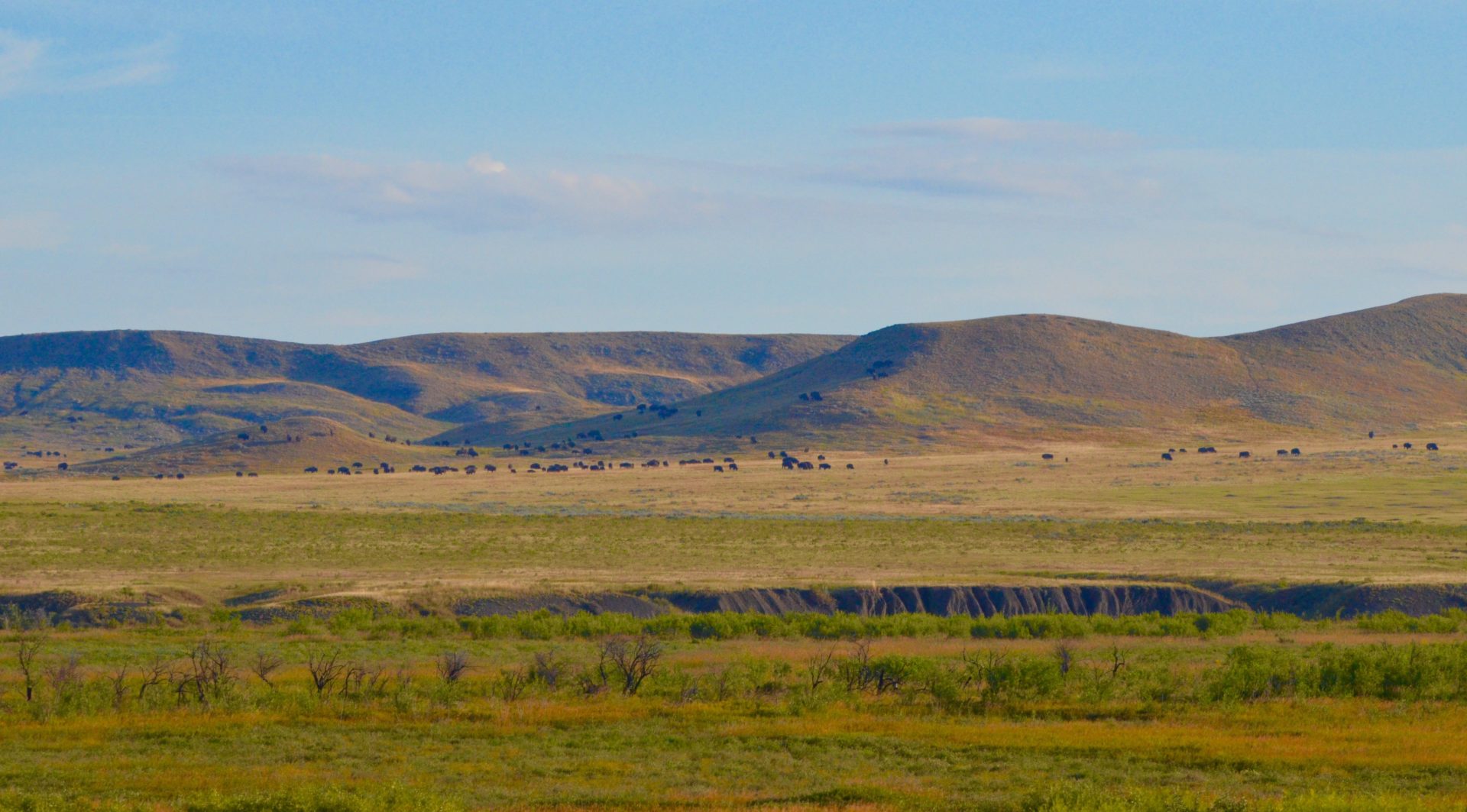
By now the prairie dogs were up and I regret not taking a video of them as they scampered, frolicked and engaged in other antics that make them the North American version of meerkats. I can remember seeing a prairie dog town outside of Fargo, North Dakota when we first moved to Manitoba. I was fascinated by them and returned years later only to see field planted with oats. Farmers and ranchers hated prairie dogs and they paid the price. We saw at least half a dozen of their ‘towns’ in Grasslands National Park and I am eternally grateful that we have cut them at least a little slack.
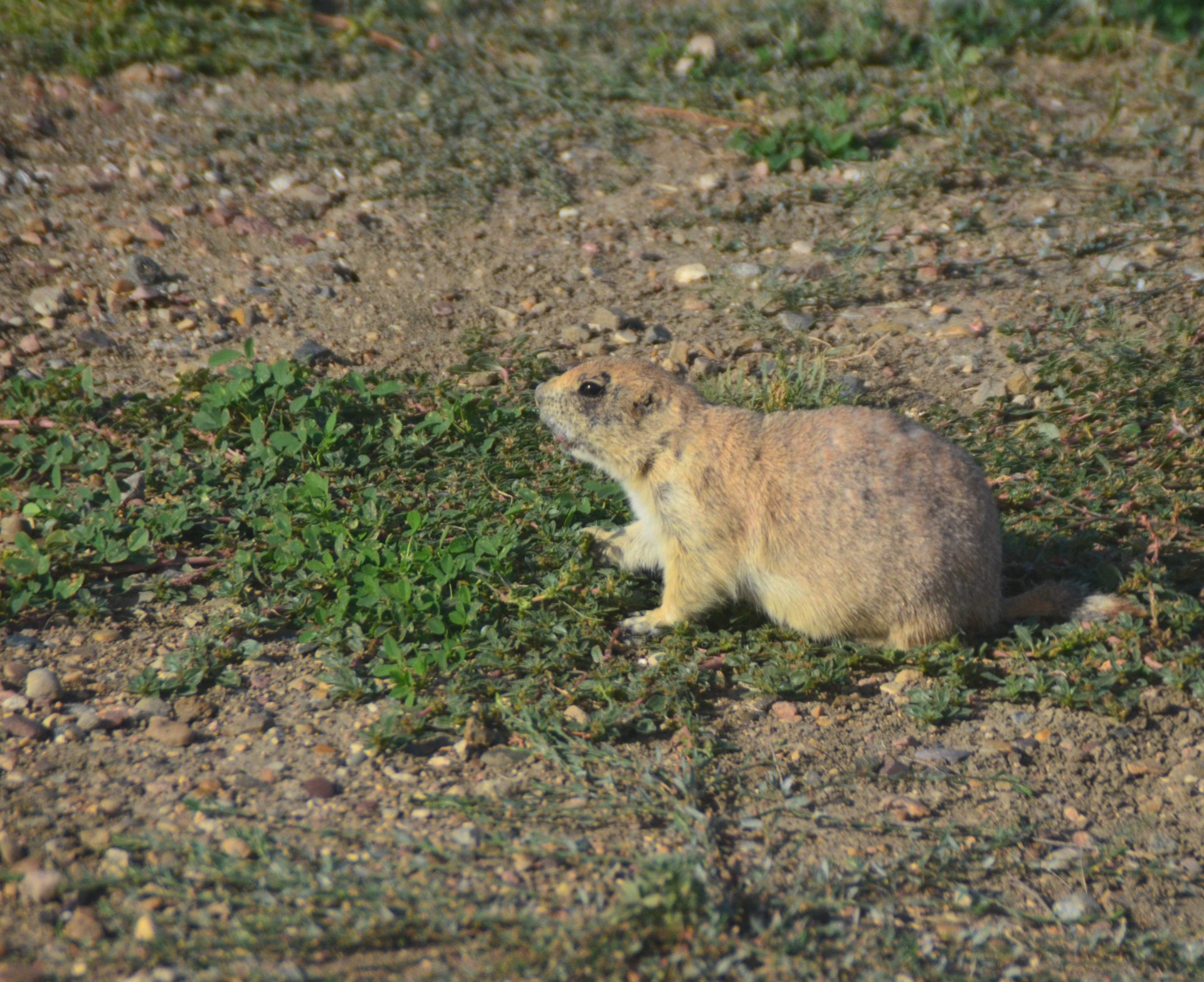
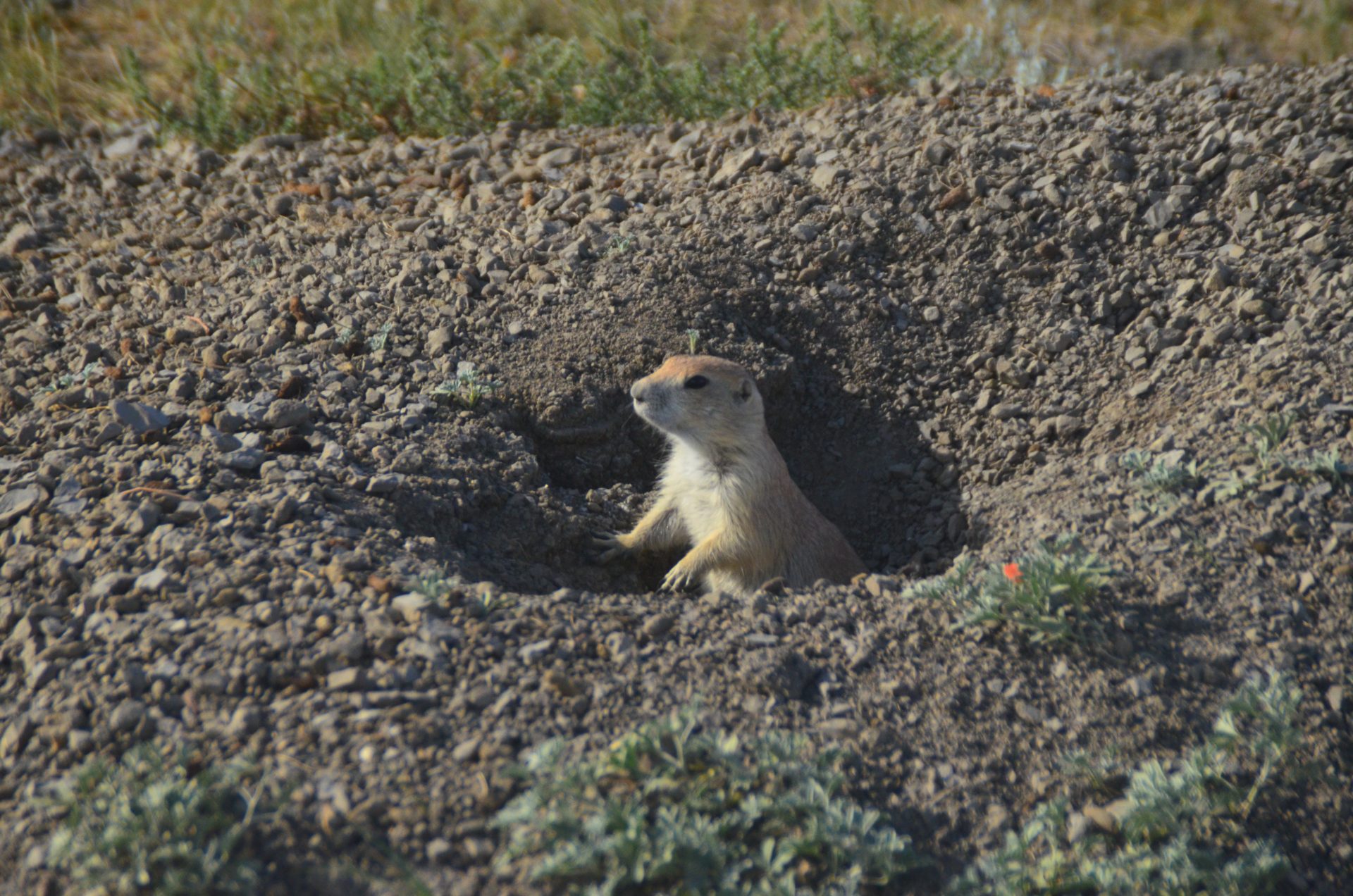
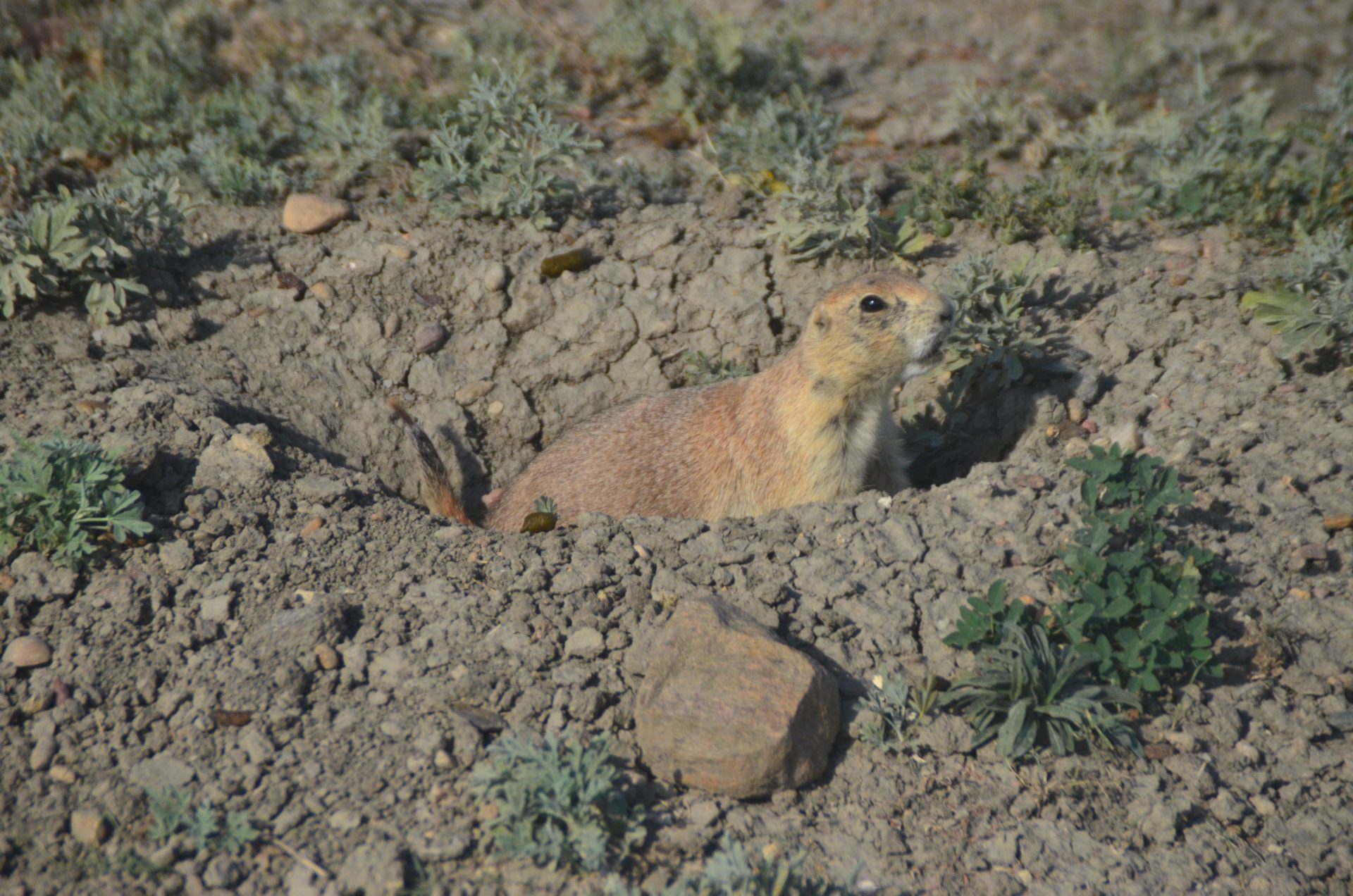
Last up were the burrowing owls who are also residents of the prairie dog towns. Like the little rodents, burrowing owls have become quite rare as their habitat has been ploughed under, but here they live in peace with their neighbours and instead dine on mice and insects. Like sandpipers, they seem to think having one leg to stand on is better than two.
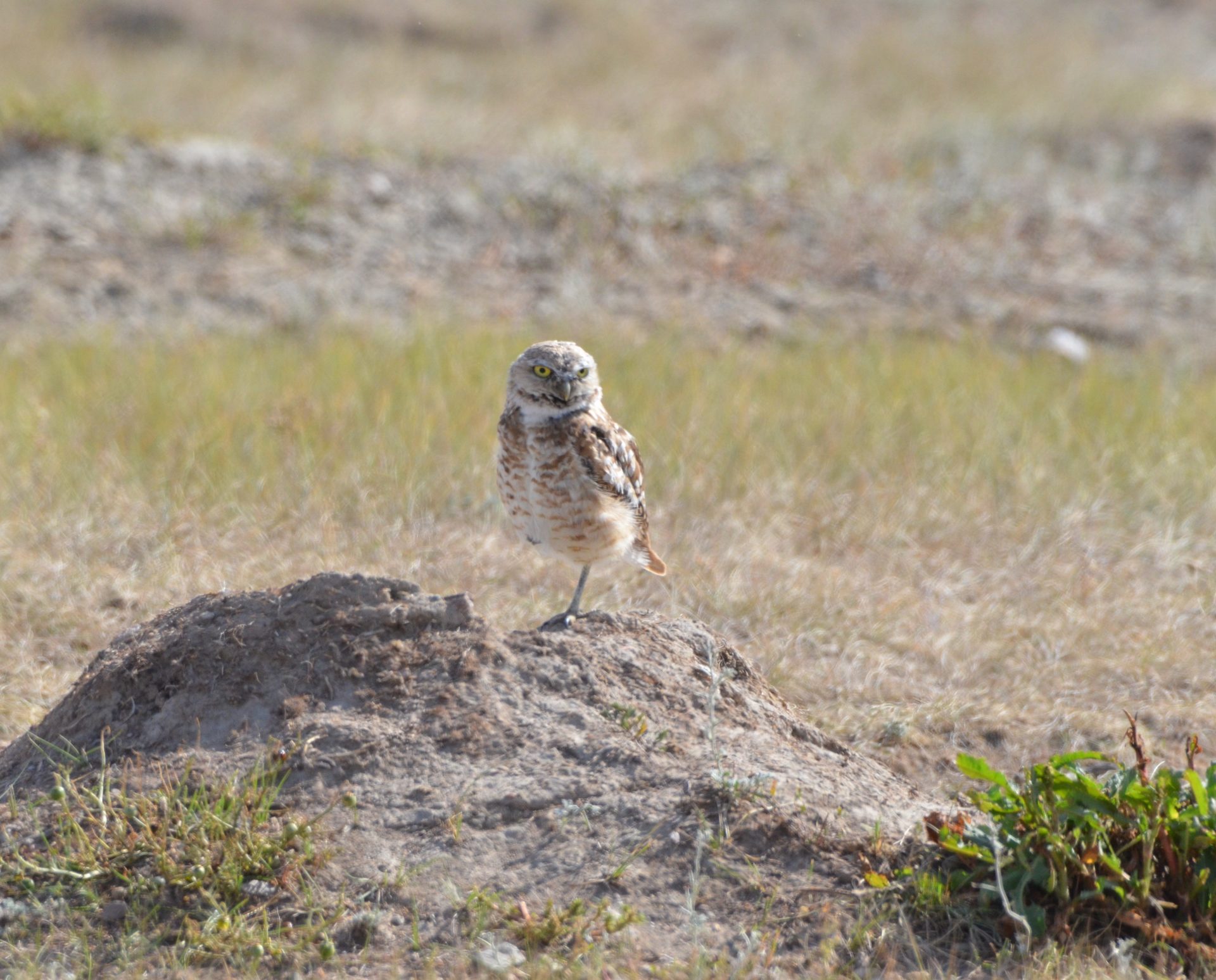
In addition to the animals above we saw at least four species of hawks or falcons, grouse and many smaller birds including meadowlarks and horned larks. One could easily spend the entire day driving back and force within the park looking for more.
No. 10 – The Intangibles
There is something about Grasslands National Park that makes the overall experience greater than the sum total of all the things I’ve mentioned above. I know it’s an environment that is unlike any I have seen before and it’s there for anybody who has the desire to look into the past and see the prairies for what they once were.
This post just scratches the surface of all the park has to offer. I would recommend spending at least three days just taking your time and hiking some of the longer trails. I know I’ll be back to do it. How about you?
Here is a link to a photo gallery of our entire Saskatchewan trip.

